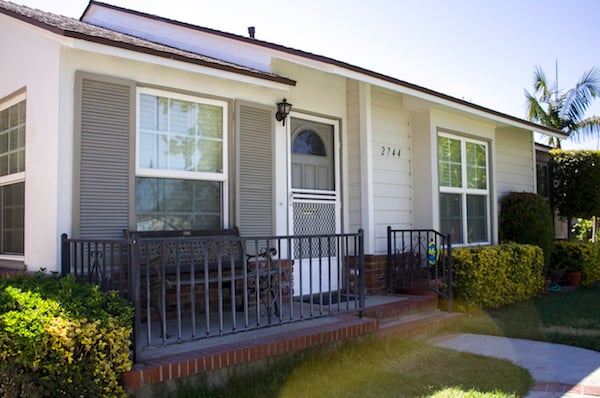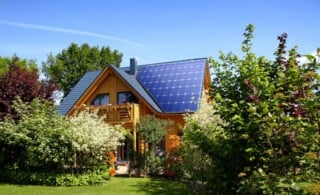
Painting and staining are often overlooked when it comes to green remodeling, especially when it comes to exterior projects. After all, a green exterior paint job isn’t going to improve a home’s energy efficiency, cut energy costs, or reduce fossil fuel consumption. On the other hand, going green is just as much about creating healthier homes, using safer building materials, and being good to the environment as a whole as it is about improving energy efficiency. Along those lines, exterior paints and stains can contribute to indoor and outdoor air pollution, negatively affect the health of homeowners, and contaminate ground water and drinking water supplies, making it a wise choice to go green anytime you’re painting in an exterior setting.
The Cost of Going Green with Exterior Finishes
The first thing homeowners want to know when the talk turns green with exterior paints and stains is how much it’s going to cost versus using traditional materials. The answer to that question isn’t as easy as many homeowners might think. At first glance, and from a financial standpoint, the answer is that you’re probably going to pay a little bit upfront for more environmentally sound, and safe, paints and stains. But when you look at things through a greener lens, the lines begin to blur. After all, what value would you place on a healthier family? On an improved quality of life? On knowing that you’re doing everything you can to create a better, more environmentally responsible world for your children and grandchildren to enjoy? Put it that way, and it’s easy to see that the real value of going green extends far beyond dollars and cents.
Going Green with Exterior Paints and Stains
Just what are the benefits of going green with exterior finishes, and what steps can you take to make sure your painting or staining project is as green as they come? Here are the answers in the form of a guide to green painting and staining.
Tips for a Greener, Healthier Paint Job
The biggest reason to go green with exterior finishes is to create a healthier environment for you and your family. Here are some tips to help you make sure your exterior paint job is as healthy as possible.
- Use Low-VOC, No-VOC, or Formaldehyde-Free Paint—Traditional paints emit volatile organic compounds, and can continue to do so for years after being applied. If those VOCs make their way indoors through open windows and doors, they can contribute to poor indoor air quality and a host of health problems, including (but not limited to) cancer, respiratory problems, and central nervous system disorders. By using low- or no-VOC paints, you’ll lower your exposure to these VOCs or eliminate the risk all together.
- Use Water Based or Latex Paint—Alkyd or solvent based paints are particularly bad in the VOC department, and can contain as many as 300 toxic ingredients, half of which are carcinogenic. Water-based or latex paints use water as a thinner instead, eliminating the threat. Furthermore, and contrary to popular belief, water and latex based paints are suitable for all but the most demanding exterior applications.
- Use Paint Instead of Stains—Non-paint exterior wood finishes contain high levels of pesticides that are not present in paints. For that reason alone, painting is a greener choice when it comes to choosing an exterior finish for your home.
- Use Low-VOC, Water-based Wood Finishes—Wood finishes are usually more volatile than paints, making the selection of low-VOC and water-based finishes that much more important. Be aware that many water based finishes still contain potentially harmful solvents, biocides, and other chemicals that off-gas into the air prior to drying, though they’re still far superior from a green perspective than the alternatives.
- Practice Safe Application Procedures—Even low- and no-VOC paints and stains can have potentially adverse effects on homeowners when they are initially applied, and improper application can lead to other problems down the road. Be sure to follow the manufacturer’s application instructions, and keep interior windows and doors shut during and directly after application to reduce the amount of VOCs that make their way into your home.
Ready to start your exterior paint?
Find ProsGreen Exterior Painting Projects and the Environment
The other reason to go green with your exterior finish is because it’s easier on the environment. Here are some things you can do to make sure your exterior finish project is as environmentally friendly as possible.
- VOCs and Air Pollution—VOCs can react with sunlight to create ground level ozone— a major contributor to smog in highly populated areas. Low- and no-VOC paints and stains help to reduce this phenomenon.
- Choose Dark Colors for Exterior Stains—Darker stains protect wood better from UV rays, increase the time between re-staining projects, and you’ll need to use less stain overall when it does come time to re-treat your home.
- Buy Recycled Paints—If you aren’t picky about colors, consider purchasing recycled paint. It eliminates waste, helps to minimize groundwater contamination, and it will save you money (most recycled paints runs about $10 per gallon).
- Carefully Calculate the Amount of Paint You Need, and Dispose of Leftovers Properly—Improperly disposed of paints and stains can leach into groundwater and contaminate drinking supplies. You can minimize waste by carefully measuring out the amount of paint you’ll need in the first place, and you can help reduce unnecessary pollution by contacting the proper authorities to obtain hazardous waste disposal guidelines, or the location of paint recycling centers in your area, if you have leftovers.
Which Shade of Green is Right for You?
While going green with your exterior paint or stain job is a smart choice for you, your family, and the environment, it’s not unusual for homeowners to feel a little overwhelmed when presented with the full scope of green remodeling options. If you’re feeling unsure about how green you’re willing to go, there’s no need to worry. Going green isn’t an all-or-nothing proposition, and any step you take in a green direction is a smart one, whether you paint your home green top to bottom, or simply ask for a low-VOC paint at the paint supply store.
If you do think green is the right choice for your upcoming exterior finishing project, talk with your contractor about adopting a green building philosophy, find a contractor who specializes in green building and remodeling, or seek out the services of a green consulting firm so that you get the best possible advice on what going green is going to mean for you.
 Lead Paint Common Sense
Lead Paint Common Sense  Painting Your Home Happy: How Color Choices Affect Your Mood
Painting Your Home Happy: How Color Choices Affect Your Mood  Sustainable Home Improvements that Help Save the Planet
Sustainable Home Improvements that Help Save the Planet  Green Building Glossary
Green Building Glossary  Green Kitchens
Green Kitchens 

Are You Familiar With This Topic? Share Your Experience.